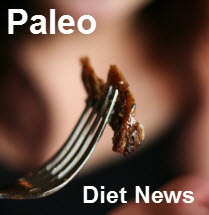The Paleoindian Paleo Diet in Pennsylvania
Mammoth hunters
Archeology and anthropology are extremely interesting fields of study in which I have an amateur interest. I especially love it when I can tie that interest in with the Paleo diet. So when I read the blog “This Week in Pennsylvania Archeology” about the Pennsylvania Historical and Museum Commission’s choice of the “Pennsylvania Foodways” as it’s theme for 2012, starting with the Paleoindian period, I had to look into it. They will be covering the “evolution of subsistence patterns” in Pennsylvania over the past 16,000 years. They are starting with the Native American diet, specifically with the Paleoindian Paleo diet in Pennsylvania.
The Paleoindian period is from 16,000 to 10,000 years ago. Basically at the end of the last glaciation.
The Paleoindian period dates between 16,000 and 10,000 years ago. It generally corresponds to the end of the Ice Age. The land that eventually became Pennsylvania was not the lush forest Native Americans enjoyed at the time of European contact. Instead it was an open spruce forest with only a few broad leafed trees such as oaks along the major streams and rivers. This environment did not contain nearly the food resources that were available to Native Americans during later time periods.
One of the biggest challenges for archeologists in researching the northeastern United State is to find the remains of organic matter that would tell them what these Paleo people ate. In other regions of the US, specifically in the west or in Florida, remain have been found to indicate what was hunted and eaten.
A major problem with determining the Paleoindian diet is the very poor preservation of organic remains such as animal bones or plant parts in the eastern United States. Unless they are partially burned, these are hardly ever preserved in the archaeological record. Much of the early speculation on the diet of Paleoindians was based on archaeology conducted in the western United States. Based on archaeological sites excavated in the west that contained the remains of mammoth, mastodon and extinct bison, archaeologists believed for a long time that Paleoindians in Pennsylvania were highly mobile, big-game hunters. In Florida, there is a growing body of data indicating mammoth steaks were part of the Paleoindian subsistence pattern. It was assumed that Paleoindians also hunted a variety of smaller animals and ate a wide variety of plant foods, but a significant part of their diet was based on now extinct Ice Age animals. However, in the Northeast, there is no association of extinct animals with Paleoindian artifacts. In fact, the East (north of Florida) does not contain much data to address the issue of diet. Therefore, answering the question of what Paleoindians ate has been a major obstacle to understanding their adaptation.
But a site was found in Pennsylvania, one of the largest in the north east. The types of tools found at the site seemed to support the big game hunting hypothesis:
Different types of projectile points, from the paleoindian period.
The Shoop site (36Da20) was one of the first Paleoindian sites reported in the East and it seemed to support the “big game hunting” hypothesis. This site is located in upper Dauphin County, nine miles east of the Susquehanna River. It is the largest Paleoindian site in Pennsylvania and one of the largest in the eastern United States. …. The site has produced over one thousand tools, including hundreds of scrapers (probably used to clean animal hides) and approximately ninety fluted spear points.
…. No food remains have been found, but it is hard to attribute the high numbers of spear points and possible hide scraping tools on a ridge top setting to anything other than hunting. Archaeologists have long speculated that this site was probably situated on a caribou or elk migration route and was visited on an annual basis to hunt these animals.
So the big game hunting Paleoindian Paleo diet in Pennsylvania seems to have been confirmed, or had it? Other sites uncovered in Pennsylvania are generally smaller and only contain a few spear points or other tools. One site in particular, in the Upper Delaware Valley, actually changed the big game hypothesis. No food remains were found, but many tools were discovered, including over 100 scrapers. However only two fluted spear points were dug up. Radio carbon dating puts the site occupation to 10,950 years ago. The limited number of spear points seems to indicate that large game was not hunted by this group. This was different than the Shoop site:
Several cooking hearths yielded a variety of carbonized seeds including hawthorn plum, ground cherry, pokeweed, goosefoot (lambs quarter), hackberry, pigweed, grape, blackberry and fish bone. ….. The occupants of this site seem to be generalized foragers rather than big game hunters. Compared to the Shoop site, there is no evidence in the form of large numbers of stone spear points for extensive hunting …. The remaining toolstone originated less than 100 miles from its source which suggests a territory much smaller than the Shoop site.
So what can this mean? In the same region you have two sites with widely varying artifacts and food remains. The conclusion of the archeologists:
These two sites present very different pictures of Paleoindian subsistence patterns and the Paleoindian lifestyle. However, when we begin to examine Paleoindian sites to the north in New England and Canada or to the south in Virginia and the Carolinas, a pattern begins to emerge. There are several sites in New England that are similar to Shoop with large numbers of spear points and hide scrapers made in stone that was transported hundreds of miles. At several of these sites fragments of burned caribou bone has been recovered verifying the exploitation of this animal. To the south, Paleoindian habitation sites are small, containing small numbers of finished spear points, a variety of tool types and these are frequently made in stone from sources less than 100 miles away. These two types of sites seem to represent different subsistence patterns; one exploiting a variety of plants, animals and fish and the other utilizing at least some of their time exploiting migratory game such as caribou, elk, or migratory birds.
It appears as though Pennsylvania on the edge of these two Paleoindian Paleo diets. To the north you have big game hunting of caribou especially and to the south more foraging and fishing.
… During the Paleoindian period in both regions people moved their camps in a seasonal pattern or “round” to the locations of predictable food resources, such as along the migration routes of caribou, water fowl, or anadromous (spawning) fish. The seasonal round also included a number of plant-food collecting sites although we do not know much about these. Compared to later groups, their seasonal round was very large covering over 100 miles. In the northern part of the state there is evidence for the hunting of migratory caribou. In the southern part of state, general foraging in the form of gathering seeds, nuts, berries, roots and fishing was more common. Their subsistence strategy involved collecting the most concentrated foods and those that did not require any special processing….
….Although, the overall quantity of food in this environment was low, the human population was also small permitting their choice of foods that were the easiest to collect. Although hunting probably dominated Paleoindian subsistence in Pennsylvania, they were not primarily big game hunters and approximately 40% of their diet was from seeds, nuts berries and roots.
The two different types of subsistence discovered, big game hunters and foragers/fishers, shows us that the Paleoindian Paleo Diet in Pennsylvania is representative of how we can successfully follow the Paleo diet today. Some people complain that the Paleo diet is all bacon and beef with very few plant foods. For some followers that is true. But they do it because they feel good eating more animal protein. These are our big game hunters. For others, the foraging diet feels better. Lots of veggies, fruits, some nuts along with small game and fish. Both are legitimate forms of the Paleo diet. And these are just two possible forms of the Paleo diet. There are many more possibilities.
What form of the Paleo diet do you prefer? Are you a big game hunter? A forager? Seafood lover? Please share your comments, questions and observations below. And please share and like on Facebook and Twitter. Thank you for visiting!






I wonder sometimes about the way we extrapolate from 10 thousand years ago, to advocate for what we supposedly should eat today.
By that logic, anthropologists 10 thousand years from now, in the year 12011, could deduce that our natural diet is sweetened processed breakfast cereals, cheeseburgers, and ice cream.
What if there really is no consistent traditional human diet?
What if our “natural” diet is really just an opportunistic one, using whatever is available at the current time and place?
If the ultimate test of evolutionary fitness is survival of the species, then it seems safe to say that since our ancestors survived and reproduced on many different kinds of diets, all of the different diets must have been acceptable.
Just imagine: The back-to-the-past food purists of 12011 will be trying to recreate “ancestral” foods like hot dogs and Twinkies!
Great article, thanks guys. I think the results show as Jim says that we were opportunistic feeders, and hugely seasonally affected.
@Jim, you are right of course, todays archaeological evidence would show that twinkies and cheerios were staples, but it would also show that we died in our millions from inflammatory / disease issues and required hospitals that could admit oversize patients etc, where as the archaeological evidence from the times of the previous diets are that people tended to die either when very young, or from trauma. We can surmise that they generally led less ‘disease’ afflicted lives than ourselves which is one of the primary goals of dietary improvements.
I think you’re probably right, that there is no one perfect diet, but there are lessons to be learnt (and forgotten) from those that lived before us.